We try to store at least a year’s supply of food in every possible nook-and-cranny on our homestead (someday, maybe, we’ll get more organized about it and have it all in one location…).
As a homesteader, I understand the need for self-reliance and food security, and both have a pretty big role in this lifestyle. I also firmly believe that you don’t need to be a Homesteader, Emergency Prepper, or Survivalist to take control and store a year’s worth of food.
In the last few years, many have struggled through a pandemic, natural disasters, and shortages across the country. I think now more than ever it is time for people from all walks of life to start thinking about how to take control of their food supply.
When it comes to long-term food storage, I can’t offer you a one size fits all solution because there isn’t one. However, what I CAN do is explain different details that will help you learn how to store a year’s worth of food and help customize it to fit your needs.
Storing food long-term is no simple task and there are many things to consider before diving in. To have success with your long-term food storage, you will need to start with a well-thought-out plan and hopefully end with a well-stocked pantry.
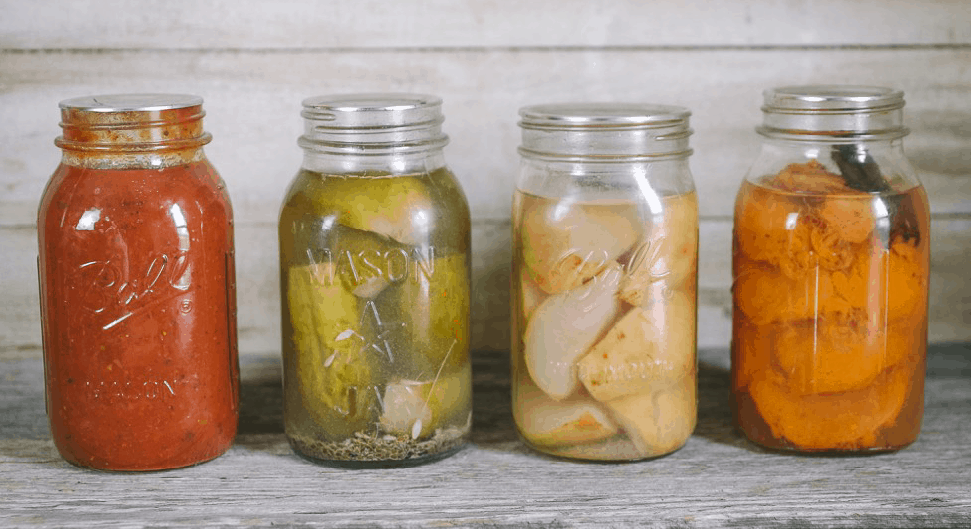
Why Store a Year’s Worth of Food
Everyone has their reasons for deciding to stock their pantries for an extended period of time. If you are still on the fence about why you really want to start storing food long-term, here are a few reasons to help you decide.
- Save Time – Storing food whether it be for a week, a month or a year will help save you time in the long run. Having food stored on hand will minimize the time you spend at stores, and in some cases minimize the time it takes to prepare meals.
- Save Money – When you buy items in bulk you are saving money because most times the price per unit is lower than when purchased individually. Growing your own produce can save money as well, you are paying for the cost of seeds or transplants.
- Emergencies – Emergencies can be natural disasters, a pandemic, the loss of a job, or a major injury. Many things can fall into this category. Having your food stored long-term means that you will have less to worry about at the time something like this occurs.
- Environmental Friendly – Buying things in bulk and preserving uses less packaging and causes less waste. Canning jars can be used over and over again, and there are now reusable lid alternatives.
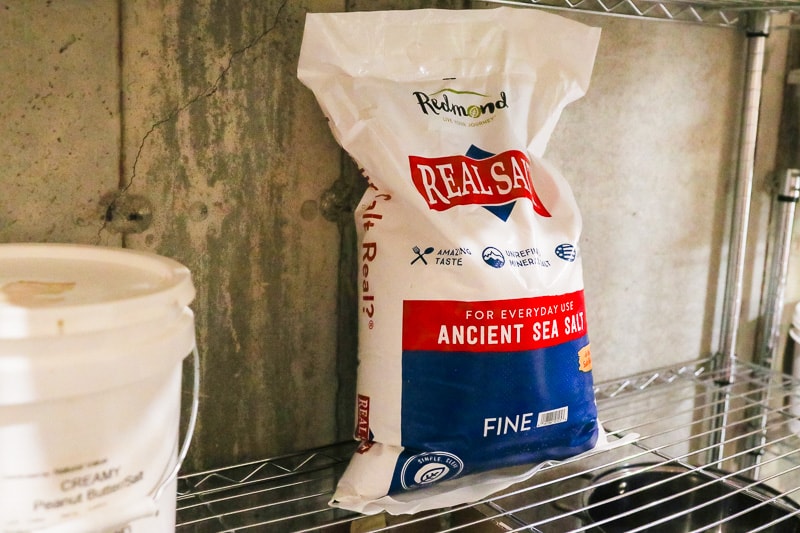
We buy Redmond’s Fine Sea Salt in a 25 pound bag. It’s cheaper to buy in bulk and we use it for so many things (fermenting, preserving, and from-scratch meals) that it made sense to get a large bag.
Where to Begin When Storing a Year’s Worth of Food
If you have decided to take control of your food security and would like to attempt storing long-term, my best advice is to start small. Many make the mistake of jumping in both feet first when it comes to long-term food storage and then they end up overwhelmed and with food waste.
Tips Before You Start Storing Food:
- Don’t try storing an entire year’s worth of food from scratch. Start small: plan for 1 month of storage and then build from there.
- Keep track of your inventory and storage space.
- Buying in bulk can save you time and money.
- Store a few key ingredients at a time in bulk, and then move on to a different one.
- If you have never preserved your own food, ease into it. Don’t depend on home-preserved food entirely until you have learned the ins and outs.
- If buying fresh produce in bulk, buy in-season to help reduce the cost.
- Have a Plan! Figure out what food you will store, how much you will need, and how you will store it.
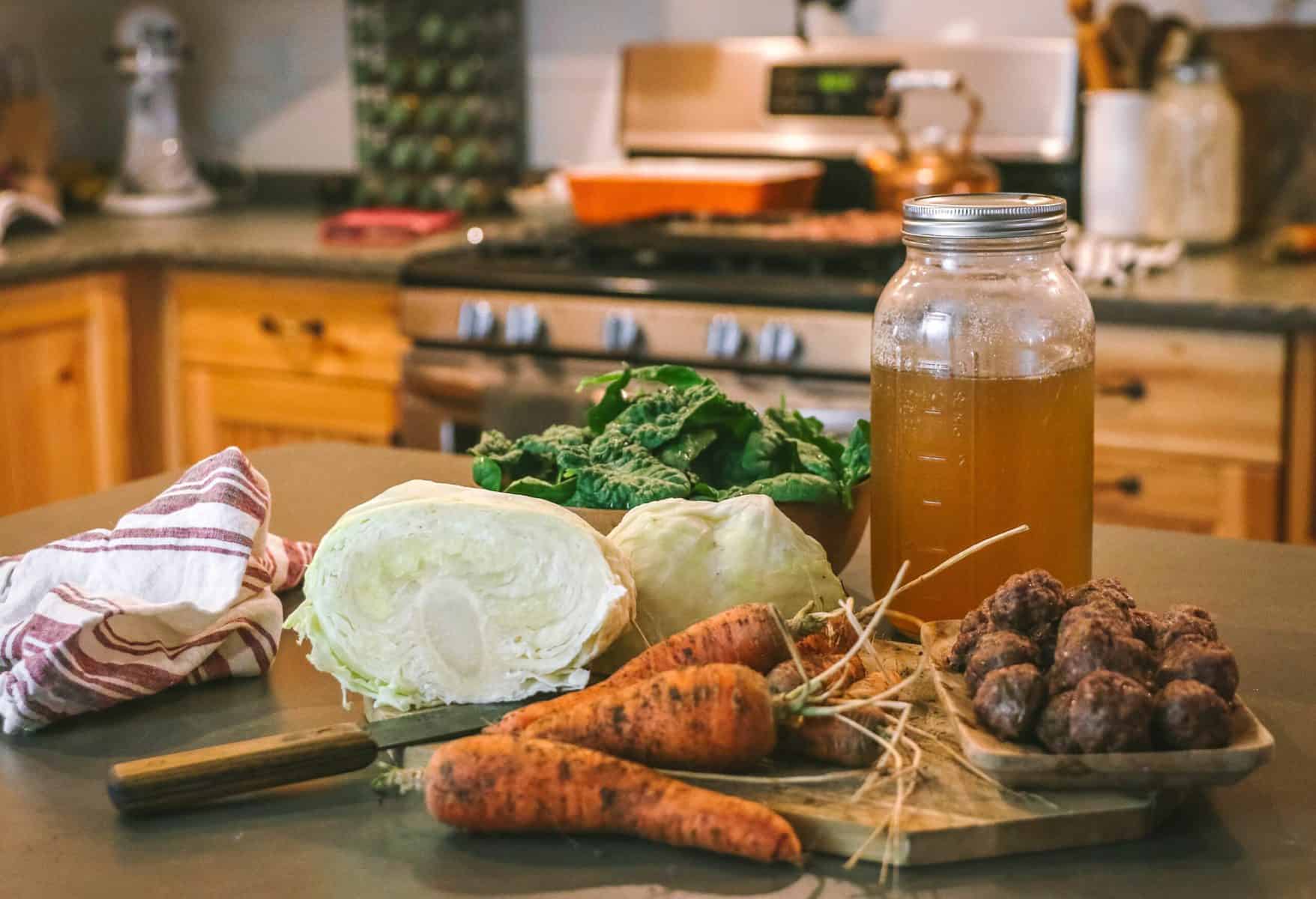
How to Create a Customized Plan to Store a Year’s Worth of Food
Before you jump in and start buying or preserving your storage items you should start with a plan. This plan will help you get organized and prevent overwhelm. Grab a pencil and some paper, take some time to write everything out (or check out the back pages from my Old-Fashioned on Purpose Planner)
Creating Your Customized Food Storage Plan:
(1) Set Realistic Actionable Goals
The beginning of any great plan starts with setting goals and having a clear idea of what you would like the outcome to be. Start by writing down your short-term goals, long-term goals, and what is motivating you to take action.
(2) Write Down What Your Family Eats
Figure out what recipes and foods your family uses most and focus on these. The goal is to store things that your family will eat.
(3) How much storage space do you have?
Your goal is to store a year’s worth of food, but you should consider how much storage space you have and where you can create more if needed.
(4) What Does Your Inventory Look Like?
Start your food storage process by going through your pantry, freezer, and root cellar (if you are lucky enough to have one) to see what you already have on hand. You will want to take everything out, go through what you use, and what you can get rid of.
Note: Organize your Pantry/Freezer, and then create an inventory sheet to keep track of what you have and what you need. It doesn’t have to be fancy, just a piece of lined paper will do.
(5) Store-Bought, Homegrown, or Both?
During the planning stage, you should decide if you will be growing produce, raising meat, preserving yourself, or buying everything. You can do all these things or only a few. If you can only raise chickens but are set on farm-fresh produce you can go to a farmers’ market. There are so many combinations and options, that is why customizing your plan to fit your situation is so important.
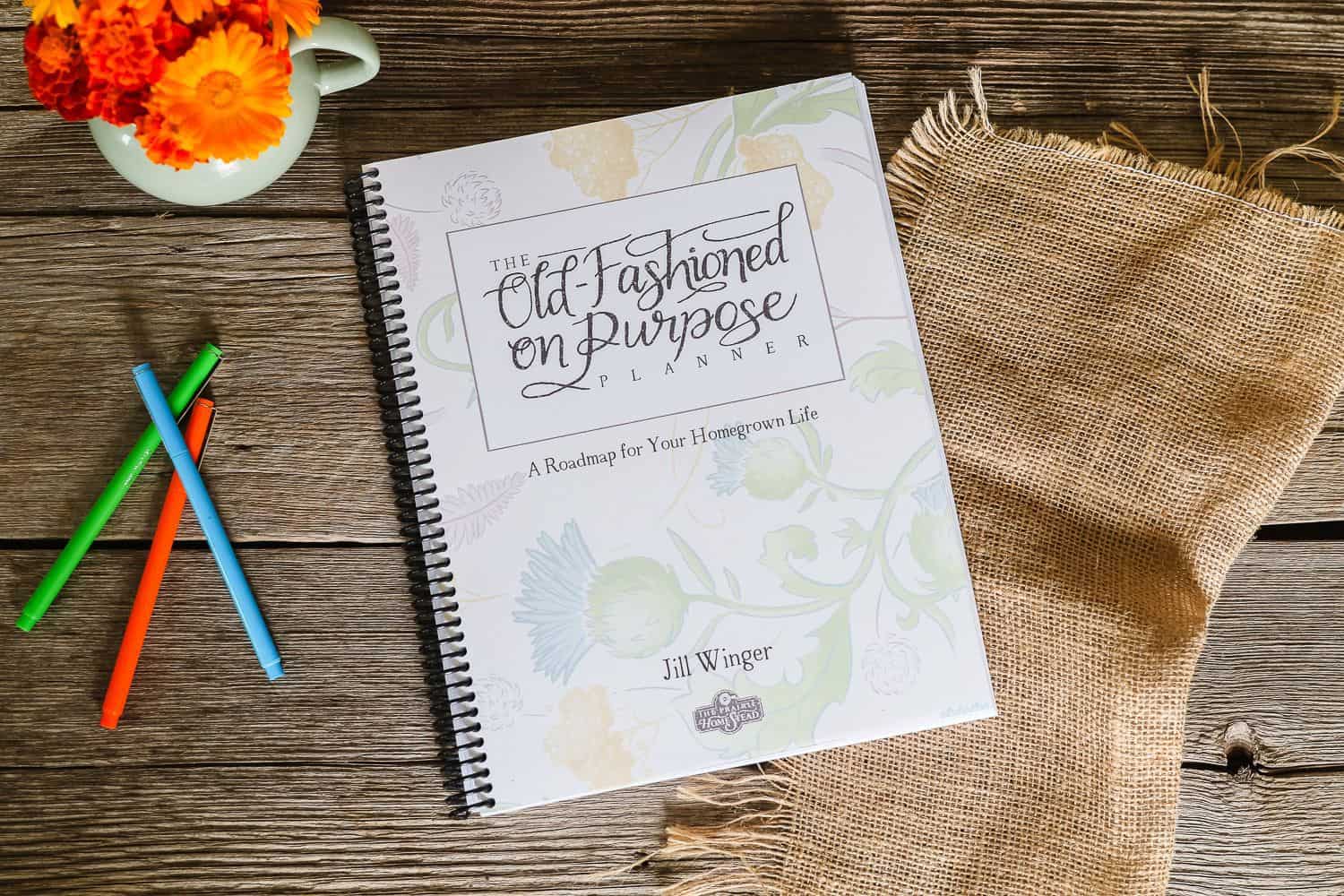
My Old-Fashioned on Purpose Planner is the PERFECT way to organize homestead and schedule. The front section is a yearly planner and in the back, I included pantry inventory and food storage sheets, as well as other helpful organization charts and sheets to help balance the busyness of a modern life with a homegrown lifestyle.
Last year’s planner SOLD OUT quickly, and we are currently printing new ones for the 2022 year. So stay tuned to my Instagram stories to learn when the new planners are available.
Organizing and Creating Your Long-term Storage Space
Before you worry about what and how much to store, you need to be sure that you have the space to store your food long-term. During your planning a list of storage space and existing inventory should have been made, now it is time to create, clean, and organize these spaces.
Note: When it comes to storage space it doesn’t have to be normal try to use what you have and get creative. Need proof? Check out my various storage areas around the home in the youtube video (above).
There are many different places you can store your food items, so consider the following spaces when deciding how much space you have to store a year’s worth of food.
Different Storage Space Ideas to Consider:
- Cupboards
- Pantry /Larder
- Root Cellar
- Closets
- Basements
- Extra Refrigerator
- Freezer
- Outbuildings
You also can organize your larger storage areas by breaking them down using smaller containers. An important thing to remember is to label your containers so there is no confusion in the future.
Containers to Help Organize Your Storage Space:
- Baskets
- Crates
- Totes
- Boxes
- Shelves
- Glass Jars
- Food Grade Buckets
Once you have figured out exactly how much space you have for storage, it is time to figure out how much food your family will need to store. Will your storage space be able to hold the amount of food required? Let’s find out!
What Food Should You Store for Your Family?
One of the major mistakes people make storing food long-term is stocking up on non-perishable items without considering what will get eaten. As mentioned earlier it is extremely important that you focus on storing things that your family will actually eat, because this will prevent food waste in the future.
In your plan (mentioned above), you wrote down favorite recipes and looked at foods your family consumes regularly. Now, you need to break down these recipes into basic ingredient lists, so later you will know what to include when buying or preserving.
If you are buying the majority of your stocked food you need to focus on things that have a long shelf-life like canned goods, pasta, rice, and dried beans. No one wants to stock up on something then find out it has spoiled in a short time.

Long-term Food Storage Items Include:
- Grains (Wheat berries have a longer shelf-life than ground flour, but a grain mill will be needed)
- Oats
- Rice
- Dry Beans
- Pasta
- Canned or Frozen Vegetables
- Canned Sauces
- Dehydrated Fruits
- Dried Herbs
- Nuts
- Peanut Butter
- Honey
- Salt
- Fats and Oils
- Canned or Frozen Meats
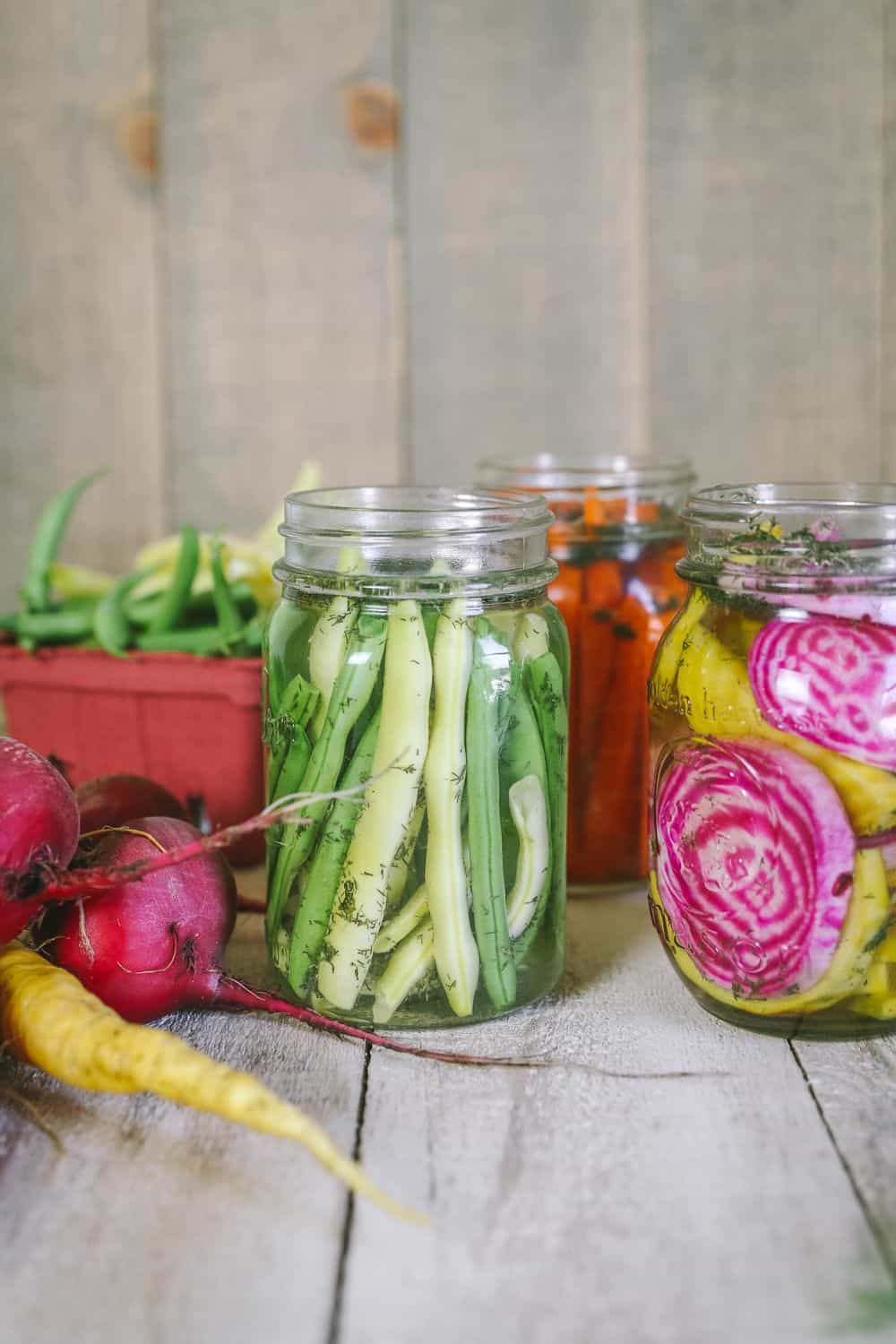
How Much Should You Store for a Year’s Worth of Food
There are different methods and calculators (check out this helpful food storage calculator) out there that can help you get close to an estimated amount to store for a year’s worth of food. These can help, but there is no one-size-fits-all solution, so you will need to adjust to customize the amount for your situation. For instance, if you have growing kids, they may eat enough for two people compared to their 40-year-old mother.
Other Things to Factor in When Deciding Your Amounts:
- Seasons – One thing that sometimes gets overlooked is the seasons. For example, if you eat vegetables with every meal, you might only need canned vegetables while fresh produce isn’t available.
- Age – Remember to consider the age of everyone in your family when customizing your amounts.
- Health – Health can be another determining factor when it comes to the amount someone will eat.
Different Methods for Figuring Out How Much You Need:
Method #1: Favorite Recipe Breakdown
Break down your favorite recipe into basic ingredients, and then multiply these by 12, now you know how much to store if you eat this once a month per year. Once you have stored that one recipe, you can move on to the next and continue until your calendar is filled with meals.
How you break down your recipes depends on how basic you would like to get with your ingredients. If you make everything from scratch, your list will include more items.
Example: Spaghetti Night
1 – 16oz Box of Noodles x 12 = 12 Boxes of Spaghetti Noodles
1 – Jar of Spaghetti Sauce x 12 = 12 Jars of Spaghetti Sauce
1 lb – Ground Beef x12 = 12 lbs Ground Beef
1 – Loaf French Bread x 12 = 12 Loaves of Bread
Note: This example is for a basic store-bought spaghetti dinner, with time and experience you can break this down further into the most basic homemade versions (like homemade pasta and homemade French bread)
Method #2: Food Per Person Per Day
Write out how much and what each family member usually eats per day, then multiply these findings by 7 and you now have an idea of how much is consumed in 1 week. Use your one week and build up to 1 month, and then a year.
Method #3: Batch Cooking
Batch cooking is one of my favorite ways to store food and save time. If you are planning on making vegetable soup for dinner one night, just make extra, and then either can or freeze the extra soup for dinners on different nights. You may not be able to batch cook for an entire year, but if you continue doing that for a time you can build up to it.
Using batch cooking for your long-term storage system again requires that you break down your recipes into the basic ingredients and multiply the amount of each ingredient by the amount you are making.
Example: Vegetable Soup Ingredients x 4 = 4 Dinners = 1 Vegetable Soup Dinner per 4 months
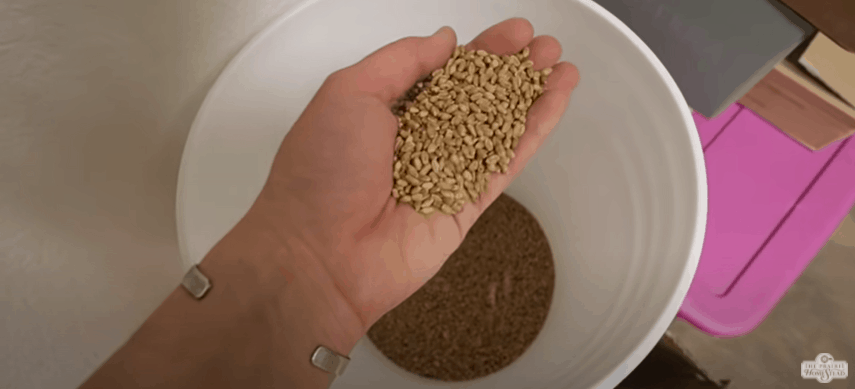
How To Build Your Food Storage
Tip 1: Buy More at a Time
In the beginning of your food storage quest, buying truly in bulk can be a struggle. There are a few different ways you can go about buying extra as you go. My number #1 tip: Focus on one product and start buying extra every time you are at the store in order to build up a supply and then move on to another.
You can also focus on one recipe that your family enjoys and buy your ingredients for it, and once you have your set amount, move on to the next one. This method can be continued until you have all your desired meals.
Tip 2: Buy In Bulk
Become a member of a large store such as Costco, where most of the things you will be looking for will be sold in bulk. When you are truly buying your items in bulk this will save you both time and money.
Tip 3: Grow Your Own/Homegrown
If it’s possible for you, grow your own food, and that can mean produce, meat, eggs, honey, or anything that you are producing yourself. If you have the time and space, you can grow a year’s worth of produce to preserve. Keep chickens for meat and eggs or maybe someday work up to buying and raising a pig (watch how to figure out the cost of raising your own meat here).
Growing your own produce and raising your own meat is great because you know exactly where your food supply is coming from.
If you have your heart set on growing your own produce you will need to consider:
- Your Growing Space
- Growing Zone/ Climate
- What Vegetables Your Family Needs
- How Many Plants Needed
When growing your own produce, you will have to figure out the number of plants you will need to plant to be able to preserve a year’s worth. If you are a gardening and preserving beginner, it might be easier to focus on one crop starting out.
Tomatoes are usually a go-to example because it is such a versatile fruit in many different recipes, you have your tomato sauce, tomato paste, pizza sauce, and even sun-dried tomatoes to name a few. To get enough tomatoes for any of these tomato products you will need 3-5 plants per person.
To get a better explanation, watch my video Know Exactly How Much to Plant to Feed Your Family where I talk you through an equation that helps me figure out how much to plant.
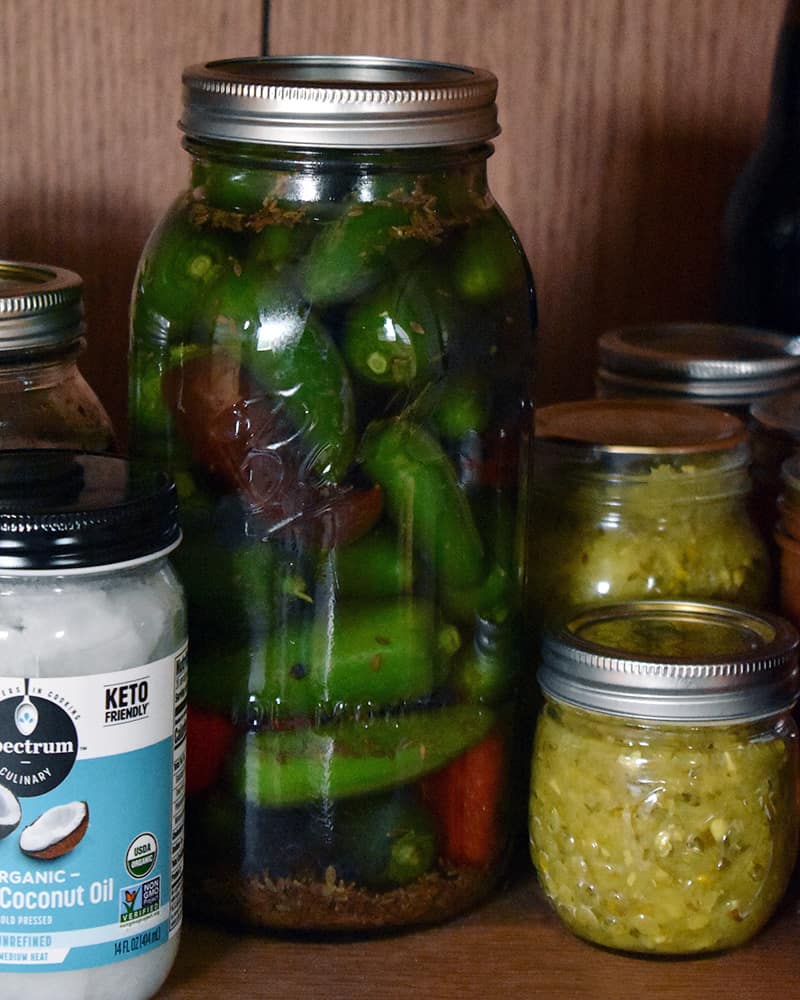
Tip 4: Preserve Your Own Storage Items
Preserving your food does not necessarily mean growing your own food, although they do go hand-in-hand. To preserve your own goods, you can buy them from farmer’s markets, roadside stands, or from a local producer directly.
If you have decided to take the leap into home preserving, then you should know that there are different methods. You can use just one method or a combination of them, whatever will make things easier on you in the long run.
Preservation Methods to Choose From:
(1) Canning
The Canning preservation method is one of the most used for long-term storage. Depending on what you are planning to store you can hot water bath (learn how to water bath can) or pressure can your items. There are rules that should be followed, and canning safety should never be taken lightly.
Here are a Few of my Favorite Canning Recipes:
- Canning Chicken (How to do it Safely)
- How to Can Tomatoes Safely at Home
- Canning Peaches with Honey and Cinnamon
If you think that canning is going to be too difficult or require too much fancy equipment, I can help with that! Learn how to can with my Canning Made Easy Course and also take a look at my tips on How to Can Food with No Special Equipment.
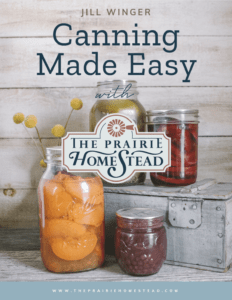
CANNING MADE EASY COURSE:
If you are a canning newbie, I just revamped my Canning Made Easy course and it’s ready for YOU! I’ll walk you through each step of the process (safety is my #1 priority!), so you can finally learn to can confidently, without the stress. CLICK HERE to have a look at the course and ALL the bonuses that come with it.
(2) Freezing
Freezing works well for certain types of vegetables and most meats, the downfall to freezing is that in an emergency where power is lost your freezer will not be working. This is also a method that may require some blanching before your things get moved to the freezer.
Here are a Few of my Favorite Freezer Recipes :
(3) Root Cellaring/Cold Storage
This type of storage isn’t for all kinds of produce, it is used for winter squash, carrots, potatoes, beets, and other vegetables that like to be kept cool and in the dark. You don’t have to have an actual root cellar to store things this way, but it helps.
Here are some helpful Root Vegetable Tips:
- 13 Root Cellar Alternatives
- Digging Up and Storing Potatoes for Winter
- How to Grow Your Best Onion Crop Ever
(4) Dehydrating
The dehydrating method is when you use a dehydrator or oven to remove the moisture from the chosen food. Foods that are dehydrated can be great additions to soups because many can be restored by adding water. Dehydrated foods do not take up as much space as other preserved foods, so this can help if you don’t have much long-term storage space.
A Few of My Favorite Ways to Use a Dehydrator:
(5) Fermentation
This method of preservation has been used for ages and because of the salt brine used it is one of the safest. Fermentation is also a very basic method of preservation, only salt, vegetables and a jar are required.
A Few of My favorite fermenting Recipes
I have personally use each of these food storage methods, and using a combination of each of them really helps achieve your food storage goals.
Never preserved anything before? That’s ok, learn more about each method and how to preserve your harvest here.
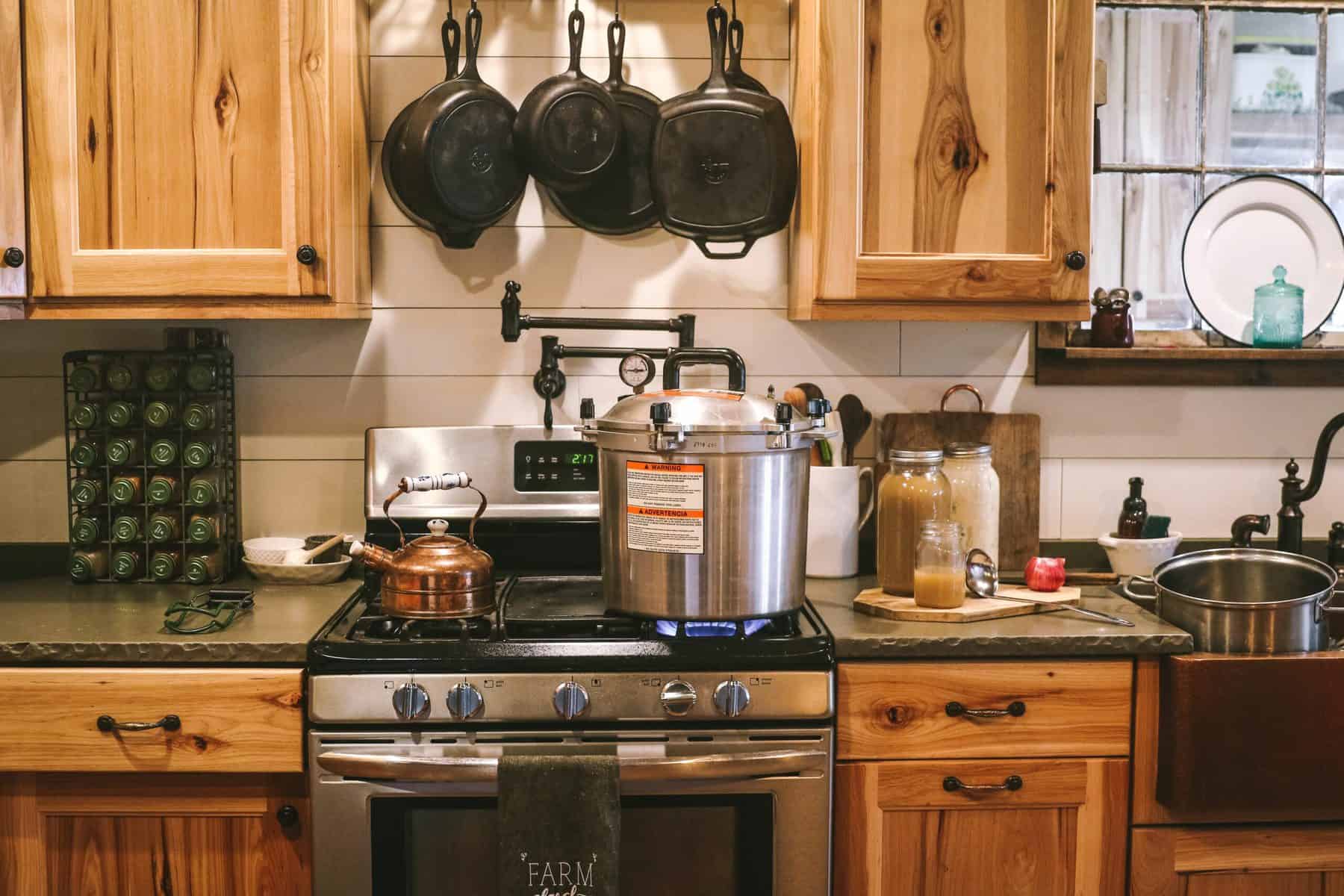
Are You Ready to Start Storing a Year’s Worth of Food Your Family?
The idea is to try and store enough to get you through one year, if you are new to food storage, just remember that the best way to prevent disappointment and waste is to start small. Create a customized plan that works best for YOUR family and decide what you will need to buy or produce yourself.
I hope your food storage journey is successful and that you are able to take control of your food supply. It is a great and satisfying feeling to finally be self-sufficient and prepared.
More Long-Term Storage Tips:
- Water Glassing Eggs: How to Preserve Your Fresh Eggs for Long-Term Storage
- The Best Resources for Safe Canning Information
- My Favorite Ways to Preserve Food at Home
- Top Tips For Storing Vegetables Without a Root Cellar
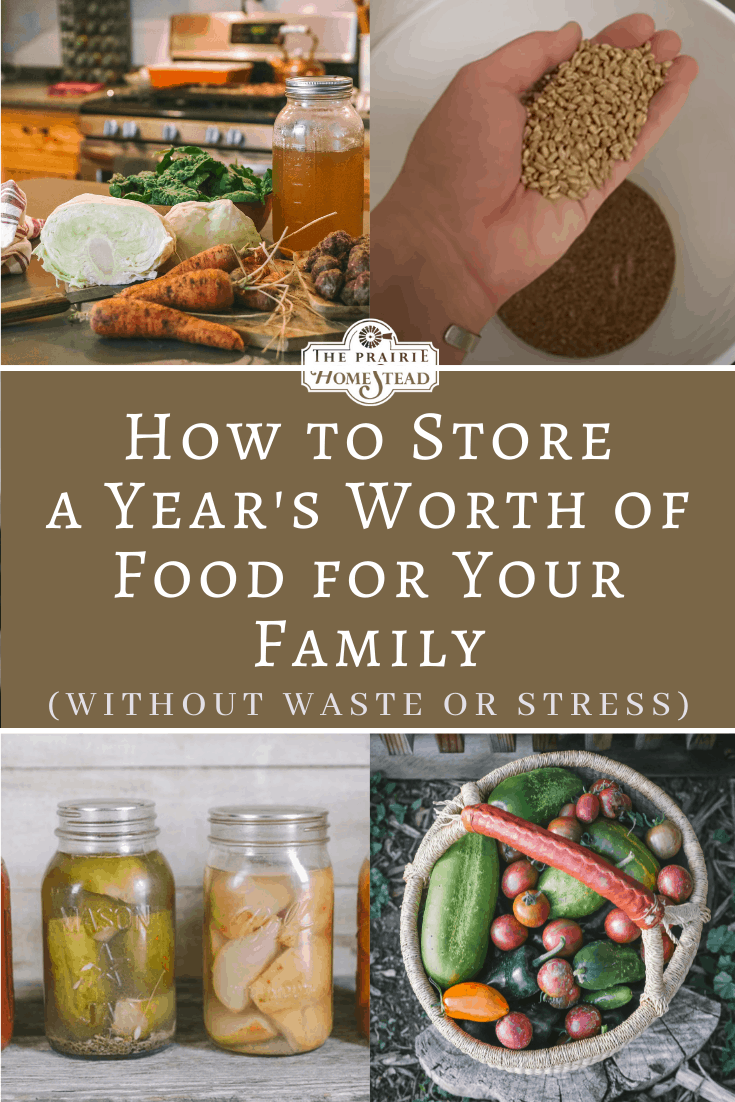
The post How to Store a Year’s Worth of Food for Your Family (Without Waste and Overwhelm) appeared first on The Prairie Homestead.
Via Gardening http://www.rssmix.com/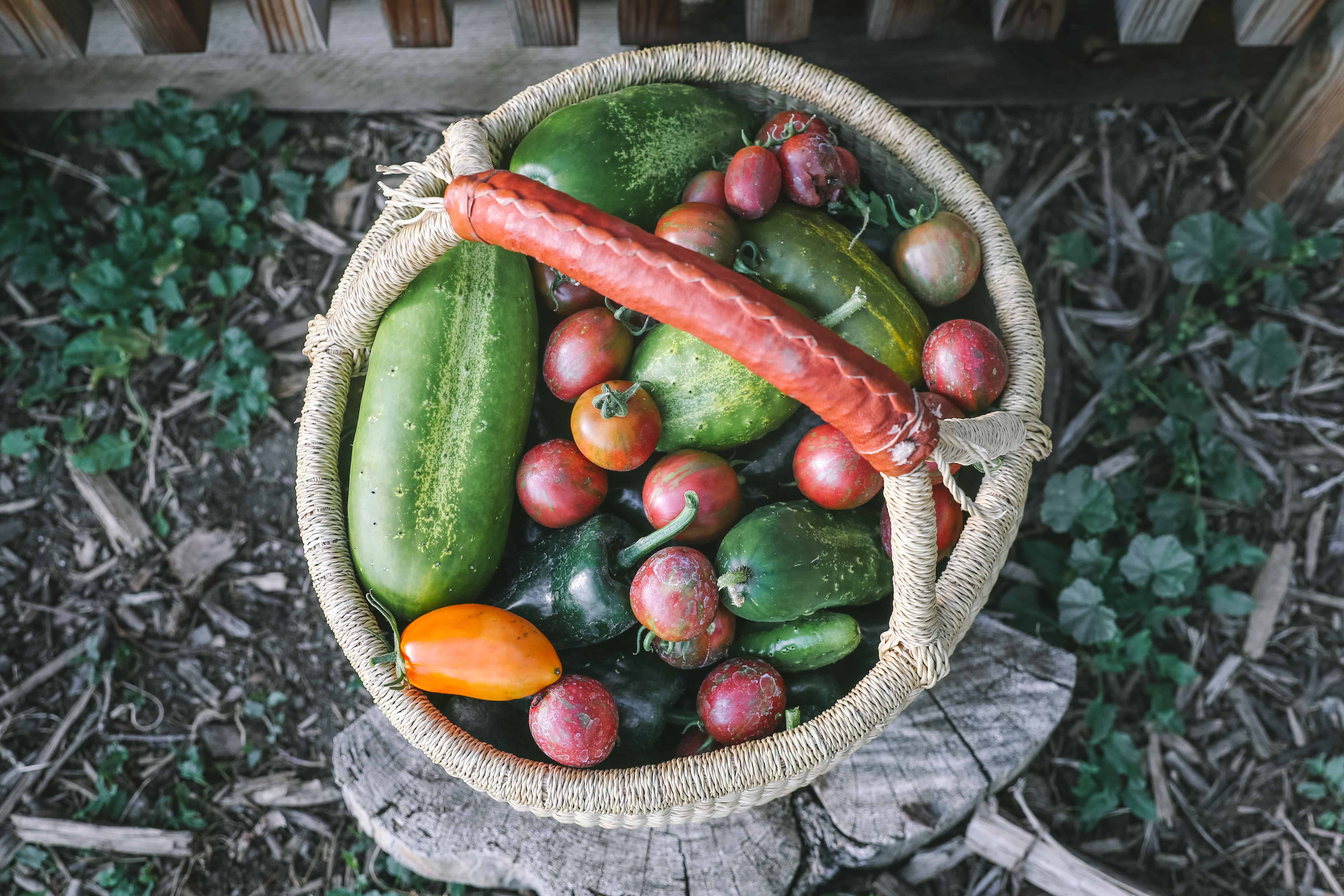
No comments:
Post a Comment